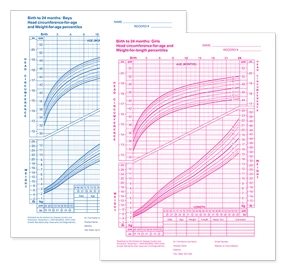
As a new parent, it's natural to wonder if your child is growing at a normal pace. Use this helpful baby growth timeline and baby growth charts from the World Health Organization to learn more about baby growth trends from birth and beyond.
Learn how to use the World Health Organization’s (WHO) international growth standard statistical distribution growth charts—the Centers for Disease Control and Prevention’s standard charts for ages newborn to 2 years old—to understand the growth of your little one.

You’ve likely seen baby boy and baby girl growth charts during visits to the doctor, but if your physician hasn’t explained them to you, you may find them confusing to read. First, let’s demystify what, exactly, baby growth charts actually measure:
By comparing one measurement against another, that will create a data point that falls along a grid onto which several percentiles have been defined. By looking at the line between data points on the baby growth chart, your baby’s rate of development can be tracked against these percentiles.
BMI—a screening tool to figure out weight category—will not be measured until your little one is over 2 years old.
The WHO baby growth charts include baby boy growth charts and baby girl growth charts, and two chart types in each category. To explore each of the World Health Organization (WHO) baby growth charts and print copies for your own at-home use, download them here.
Download Growth ChartsThe size and growth of your baby will become a routine part of each doctor’s visit. During each baby checkup the doctor will be measuring a few things:
Baby growth charts are developed using data gained from weighing and measuring thousands of kids to create percentiles. If your little one falls in the 50th percentile, this just means that 50% of those measured at the same age as your baby are higher and 50% are lower. It’s important to note that lower percentiles do not necessarily mean anything is wrong with your baby. There are many factors to consider. For example, if both parents are taller than average or shorter than average it would be normal for the child to follow suit as they grow up.
The rate of growth—not percentile numbers—is what is most important to take away from a baby growth chart. Baby growth charts have been designed to track the trend of your baby’s growth—to ensure baby’s rate of growth is appropriate and follows their percentile’s line.
Times at which a pediatrician may view baby’s percentile as concerning include:
There are other growth benchmarks and age-related milestones to consider while monitoring your growing little one, including feeding-related changes. Here are some common points to keep in mind, based on averages.
Your pediatrician will keep track of your baby’s growth, but it’s always good to have a sense of what’s typical and how you can help keep your little one on track by being able to understand baby growth charts. Learn more about your baby’s milestones during their first 2 years.
All information on Enfamil, including but not limited to information about health, medical conditions, and nutrition, is intended for your general knowledge and is not a substitute for a healthcare professional's medical identification, advice, or management for specific medical conditions. You should seek medical care and consult your doctor or pediatrician for any specific health or nutrition issues. Never disregard professional medical advice or delay seeking medical treatment, care, or help because of information you have read on Enfamil.